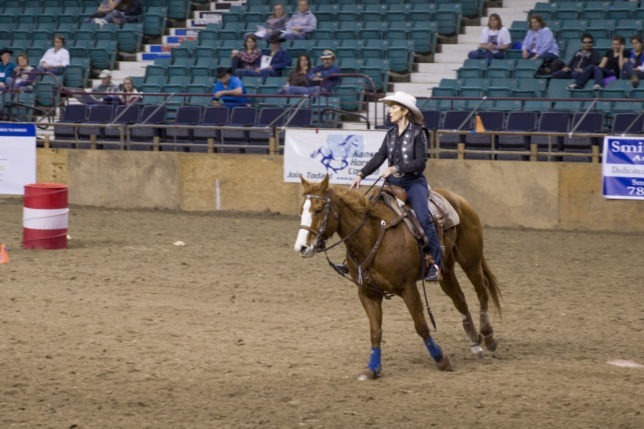“Purpose patience and passion make the best barrel horses, the best barrel racers and a better world.”
While it sounds like a motivational speaker, the flashy cowgirl on the fit athletic sorrel Quarter Horse was emphatic in that message during her half dozen public presentations as one of a handful of features clinicians at the EquiFest of Kansas in Topeka.

Enthusiastic and energetic yet humble was obvious as Sharon Camarillo demonstrated techniques developed in a lifetime of a horse-dreaming city kid who became a champion all- around cowgirl now in demand as she eagerly shares vast horse knowledge.
Anxious to have audience participation in her mounted presentations, Camarillo often had to slow down to catch her breath she rode and talked simultaneously to her horse and the apparent- spellbound audience in the bleachers.
Time between public sessions may have been for relaxation, but Camarillo had little of it seemingly as those with personal questions seeking her advice kept a line steady when she went to a sales booth offering tack and equipment she uses.
“You are only limited by your imagination,” insisted Camarillo. “But dedicated work is essential requirement to go with that.”
Cones were set in the arena and around barrels, as the clinician claimed she was “playing cards,” while providing “visual guides,” to keep the horse and rider balanced.
“Reins guide the front end, and your legs the back end,” Camarillo showed. “Softer is always better. I soften my pelvis, and it will be mirrored in my horse’s pelvis.”
When the horse is expected to turn, “the rider must face that direction, too,” according to Camarillo, as her mount’s response was most apparent.
While cowgirls might initially smirk when the English-riding term “diagonal” is said, Camarillo pointed out, “You have to have to be riding in the correct diagonal, ‘rise and fall on the wall,’ as the saying goes. for a balanced ride as your horse changes direction.”
Riding two handed with long split bridle reins on a long-shanked snaffle bit, the clinician pointed out: “A martingale is a simple tool to keep the horse balanced, too.”
In another presentation, Camarillo’s horse, with a tie down, was tacked in a shorter-shanked snaffle bit. A tightened cavesson, halter-semblance noseband, assisted in keeping the horse’s mouth shut.
As her mount broke the canter into a trot, Camarillo admitted, “He’s funny about that,” as she tapped him with an inside rein.
Without spurs, Camarillo “bumped” the horse with the calf of her leg asking him to pick up into a slow canter as maneuvered first around the large cone-marked course, then making the circle smaller within, before changing directions and leads.
“Come on, this is not a pleasure class,” Camarillo insisted as the horse slowed, before being tightened around the barrel, also enclosed by a triangle of cones to position horse and rider for maximum efficiency of turn.
While cantering seems a more common gait for majority of riders, the clinician spent majority of the time in a trot turning 45 degrees one direction then the other, zig zagging through the course, and intermitted going around the barrel.
“Your horse must learn the pattern, but after he knows what to do, he doesn’t need to keep doing it at home. Just ride to keep your horse and yourself fit and conditioned,” Camarillo said.
“The sport of barrel racing requires an equine athlete who has the collection skill set,” Camarillo said, while explaining the “Training Pyramid” of six buildings blocks required for an efficient barrel racing performance.
“Utilizing the pyramid is a way to improve the horse’s performance, reduce performance anxiety and increase the potential for success in the sport,” Camarillo said. “For the horse and rider to advance to the next level, they must have a clear understanding and proficiency within the previous level.”
The horse must have rhythm and forward motion with “regular footfalls.”
Suppleness is “the ability to identify flex and control of the body zones, the neck shoulder, rib and hip, laterally and longitudinally in a relaxed and controlled manner,” explained Camarillo, as lay listeners seemed to be scratching their heads.
Contact is the horse’s acceptance of the bit and the rider’s hands. “This includes the horse’s willingness to move forward into the bit, enabling the rider to connect
the haunches to the forehand,” Camarillo said.
Impulsion, the speaker informed, is the propulsion from the hindquarters to enable forward, lateral and reserve movement. “Straightness comes from the ability to align the horse’s body on straight and curved lines for efficient, effective movement, and requires attention by the rider, and application of the rider’s aids, seat, legs and hands,” Camarillo said.
Collection comes when the horse learns to carry his body in an athletic manner with little reminder or support from the rider. Camarillo said, “Collection allows the rider to lengthen and shorten the horse’s stride, add and control speed, while providing the ability to consistently place the horse’s body in a balanced, athletic position for efficient movement.
“Excellence is achieved in the mastery of fundamentals,” summarized Camarillo, iterating quote of an accomplished-respected football coach.